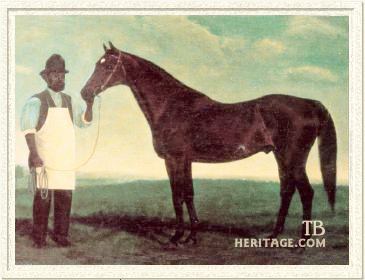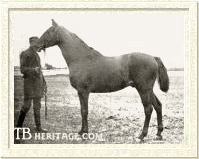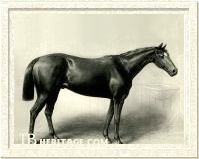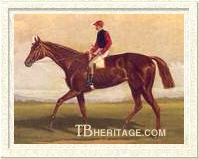|
|
Bonnie Scotland

|
|
 |
|
|
*Bonnie Scotland was bred in the purple, but after becoming a forgotten horse in England, he established one of the most important sire lines in America in the late 1800s and early 1900s.
Bred in England by Mr. Willliam I'Anson of Spring Cottage, Malton,Yorkshire, he was the seventh foal out of the tremendous producer Queen Mary, one of the most influential mares of the latter half of the 19th Century in Europe and America. This also made him a half-brother to the great filly Blink Bonny (dam of Blair Athol), Haricot, as well as *Balrownie, who also came to stand at stud in America, although with much less success.
His sire, Iago (1843, out of Sandal, by Selim), was by Don John, the 1838 winner of the Doncaster St. Leger, the Doncaster Cup, and other races; in the latter Don John had run down the other top horses of his generation, including Bee's Wing, The Doctor and Melbourne, and subsequently was hailed the best of his year. Iago was near the top of his generation, having won the Column Stakes at Newmarket, the Racing Stakes at Goodwood, and the Welcome Stakes at Ascot, and placing second in the Great Yorkshire Stakes, beaten by a head by Pynton. He ran a good second to Sir Tatton Sykes in the St. Leger Stakes, and then beat him in the Grand Duke Michael Stakes at Newmarket. He broke down in his first race of 1847, and was retired to stud.
An injury at 2 prevented *Bonnie Scotland from living up to expectations, but at 3, he won the Doncaster Stakes and Liverpool St. Leger, as well as dead-heating for runner-up position in the classic Doncaster St. Leger.
*Bonnie Scotland broke down at the end of that season and was retired to stud, making 1 season in England (resulting in 2 foals from as many mares) and due to an obvious lack of local interest, was sent to America in 1857. He was imported by Capt. Cornish of Massachusetts and stepped off the boat in New York in November of 1857. There, he was purchased by John Reeber and partner Kutz of the Fashion Stud, Lancaster, Ohio for $1,200, to replace their chief stallion *Monarch.
He covered his first American mares in 1858, including the great racemare, Fashion (for whom the enterprise was named) and who foaled his good colt DANGEROUS in 1859. *Bonnie Scotland remained at Reeber's farm through the 1867 season. Although the American Civil War eliminated most of the racing in the country, not to mention most of the serviceable horses, *Bonnie Scotland made a name for himself during this period with offspring like Dangerous; MALCOLM (c. 1862 out of Lady Lancaster by *Monarch), later sire of the great broodmare Marian (dam of Emperor of Norfolk, Yo Tambien, et al); and FROGTOWN (c. 1868 out of Ada Cheatham by Lexington), who set an American record for 10 furlongs in 1872. His early crops also included Malcolm's full sister ONTARIO (1869, later dam of Hero and Rancocas), REGENT, LOCHIEL, KELPIE (dam of Duke of Montrose), and BOURBON BELLE (dam of the great runner and sire, Hanover, and his sister Kentucky Belle II).
With runners on the track showing record-breaking speed, *Bonnie Scotland had begun to attract attention and was moved to Kentucky for the 1868 season. He was relocated yet again, to Illinois for 1868 and 1869, and sold at auction in June of 1869 for $1,000, after which he took up residence at the Glen Flora Farm of R. H. and C. C. Parks in Waukegan, Illinois. He stood here for the 1870, 1871, and 1872 seasons, the results of which did little to enhance his record. Despite his relocation to Illinois, *Bonnie Scotland's get kept his name in the headlines. He was second on the Leading Sires list in 1868 and 1871 (both times behind Lexington).
Bonnie Scotland at Belle Meade
In 1872, this performance caught the attention of Gen. William G. Harding, master of the famed Belle Meade Stud, at Nashville, Tennessee. Belle Meade was considered at the time one of the premier breeding establishments in the country. Harding had lost two of his top stallions in 1872, Vandal, and Jack Malone. Needing a replacement of top quality, Harding purchased *Bonnie Scotland and brought him to Nashville. Although the horse was 19 years old, as a proven sire with bloodlines compatible to those already established at Belle Meade, *Bonnie Scotland began the second phase of his stallion career. Standing his first season in Tennessee in 1873, the resulting crop included Withers Stakes winner BOMBAST (g. 1874 out of Benecia by Jack Malone), and later crops produced champions BRAMBLE, LUKE BLACKBURN, GLIDELIA, and GEORGE KINNEY.
|

Son Bramble established an enduring sire line

Luke Blackburn was top of his generation at age three

Glidelia, champion three year old filly
| | BRAMBLE (c. 1875 out of Ivy Leaf by *Australian) was bred by Eugene Leigh and was an outstanding distance runner, counting the Saratoga Cup, Brighton Cup, Monmouth Cup among his wins, and generally considered the best handicapper of the 1879 season. He won 31 races from 50 starts, earning $32,660. Retired to stud at Belle Meade, he was later moved to Leigh's La Belle Stud in Kentucky. Bramble sired Clifford, Prince of Melbourne, and Ben Brush, the latter establishing an enduring American line that continued with the strength of his sons Sweep (sire of The Porter, Eternal), Broomstick (sire of Whisk Broom II, Halcyon, WIldair), and Delhi (sire of Dominant).
LUKE BLACKBURN (c. 1877 out of Nevada by Lexington) was bred by Capt. James Franklin of the Kennesaw Stud, Gallatin, Tennessee. He was considered one of the best runners of his era, and the champion at 3. He retired with 25 wins in 39 starts and $49,460, leading his sire to the top of the sires' standings in 1880. Luke Blackburn retired to stud at Belle Meade to replace his sire (who died in 1880), where he died in 1904. His most important offspring was the brilliant 2-year-old Proctor Knott, winner of the first Futurity Stakes; also American Derby winner Uncle Bob (named for Belle Meade's well-known stud groom), and the mare Heartburn (dam of Salvolatile).
From the same crop as Luke Blackburn came GLIDELIA (f. 1877 out of Waltz by Lexington), champion of her age and sex at 3. George Kinney (c. 1880 out of Kathleen by Lexington) was also bred at the Kennesaw Stud, and was the division leader at 2 and 3, winning the Belmont Stakes and Dixie Handicap, although he did little as a sire. Other good ones by *Bonnie Scotland included Bulwark, Brambaletta, Barrett, By the Way, and Boatman. As illustrated by Luke Blackburn, Glidelia, and George Kinney, his best nick was with Lexington mares; Bramble's second dam was also by Lexington.
|
The most influential of *Bonnie Scotland's daughters was BOURBON BELLE, dam of Hanover and Kentucky Belle II. Others were KELPIE (dam of Duke of Montrose), BONNIE ROSE (dam of Bonnie Joe), BRUNETTE (dam of G. W. Johnson), BLINK BONNIE (gramddam of Tammany), TIBBIE DUNBAR (dam of Canny Scot), and ONTARIO (dam of Rancocas).
*Bonnie Scotland died at Belle Meade on February 1, 1880 at the age of 27 and was posthumously America's Leading Sire in 1880 (with 3-year-old champions Luke Blackburn and Glidelia) and 1882 (with 2-year-old leader George Kinney). He was third in 1879. Harding gifted his skeleton to nearby Vanderbilt University. [This continues an odd tradition for descendants of Queen Mary. The bones of *Bonnie Scotland's half-sister, Blink Bonny, are in the York City Museum in England, while those of half-brother Blinkhoolie, are at the National Stud in France.]
When *Bonnie Scotland arrived in America, he was described by turf expert Henry W. Herbert. "He was a blood bay, black-legged horse without a spot of white on him except for a star on his forehead, the richest-colored bay we have ever seen. He stands a full 16 hands high, he has the longest shoulder, deepest heart-place, best forehand, shortest saddle-place and the most powerful quarters of any horse now before the public."
As a son of the remarkable broodmare Queen Mary, he passed on quality of the highest order, and his progeny were noted for their good looks, balance, and overall soundness, not to mention speed and ability over a distance. As the grandsire of Ben Brush, and the dam's sire of Hanover, his bloodlines continued through two of the most important American sirelines of the early 20th Century.
-- Anne Peters |
|
|
|

